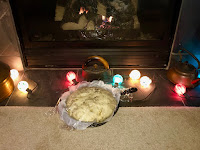Grandma was born in Norway. Her family immigrated to the States when she was a little girl. There's very little of my Norwegian heritage left except a few Christmas foods. One is Yule Kaga. It translates as Christmas cake, but it's bread.
Grandma made it every Christmas, then it was Mom's turn. Now it's mine.
Mom's recipe file had two cards, one in Grandma's handwriting and one in Mom's. Using them I created a recipe for a single loaf.
Norwegian Yule Kaga
 |
| Scald milk then add butter and sugar. |
Ingredients:
1 cup milk (scalded)
1/4 cup butter (melted)
1/4 cup sugar
1 pkg active dry yeast
3 tablespoons lukewarm water
1 egg (beaten)
3 1/2 cups flour
1 teaspoon salt
1/2 cup raisins
 |
| Activate yeast in warm water. |
1/2 cup citron
1/2 teaspoon ground cardamon
Directions:
Scald the milk.
I had to look this up. Bring the milk to almost boiling then allow it to cool slightly. Add the butter, sugar, salt and cardamom and let the mixture continue to cool until
 |
| Add egg and yeast to cooled milk. |
lukewarm.
Dissolve
the yeast in lukewarm water (100-110 degrees). If the water is too cold, the yeast won't activate. If it is too hot, the yeast will be killed. Stir occasionally. The yeast gets bubbly, releasing carbon dioxide gas, the stuff you need to make bread rise.
 |
| Beat mixture then add half of the flour. |
When the milk mixture is cooled, add the dissolved yeast followed by the well beaten egg. Beat the whole mixture until everything is fully incorporated and smooth.
Then add 1 1/2 cups of the flour. Beat thoroughly. I used a wire whisk but this could be done with an electric mixer.
 |
| Mix in the raisins and citron. |
Add the raisins and citron and blend together while the dough is still in a liquid form.
Add the remaining flour a little at a time. At this point I switched from the whisk to a large wooden spoon. At the end, it was easier to mix the last of the dry flour in with my hands.
 |
| Add remaining flour slowly. |
Turn the dough out onto a floured board. Knead for 8-10 minutes until the dough becomes smooth and elastic. Work in any citron and raisins that escaped.
Place dough in a large greased bowl. I used soft margarine. Roll the dough over in the bowl to get some of the margarine on top of
 |
| Knead on a floured bread board. |
the dough to keep it from drying out. Cover the bowl. I used plastic wrap covered with a tea towel. Grandma's recipe card called for a damp cloth.
Let the dough rise in a warm place for about two hours, or until double in size. Mine took one and a half hours in front of the fireplace.
 |
| Let the dough rise in a warm place. |
Punch the dough down and form it into a round loaf.
I used 9-inch cast iron frying pan for my round loaf. I lined it with parchment paper and moistened the top of the dough with cooking oil spray. Loosely cover. I used plastic wrap again.
 |
| Form a loaf and let it rise. |
Place the dough in a warm place and let it double in size again (about 45 minutes).
Bake in a 350 degree oven for 40-50 minutes or until golden brown. Test by tapping the top with your finger. It should have a hollow sound when it's done.
Remove the bread from its pan
 |
| Bake until golden brown. |
and cool completely on a rack. If you like a crispy crust, store it in a paper bag. If you want a soft crust, store it in an airtight plastic bag.
For me, Yule Kage is not complete without
gjetost cheese on top. The brand I find in the States is
Ski Queen.
It's a semi-hard cheese made from whey, milk, goat milk and cream. It has caramel colour, has a unique flavour, and melts in your mouth. It always reminds me of going to Grandma's house for Christmas.
 |
| Cooling and ready to eat. |
I couldn't wait. I cut a slice, toasted it with butter, and topped it with gjetost. Closing my eyes I could feel my family enjoying Christmas and New Years morning with me once again.
Do you have any traditional holiday foods that make you feel connected to your heritage? -- Margy




































































